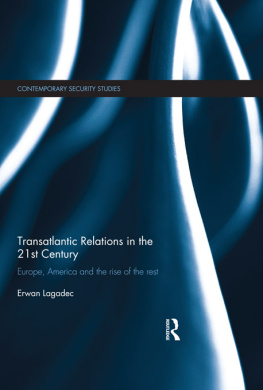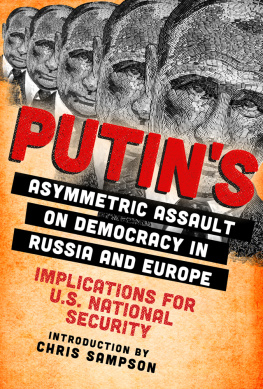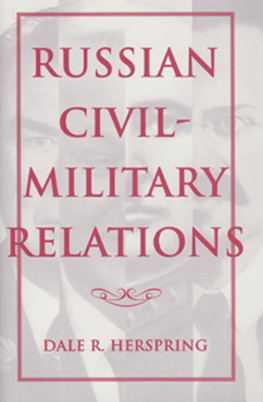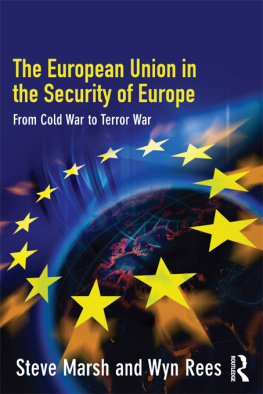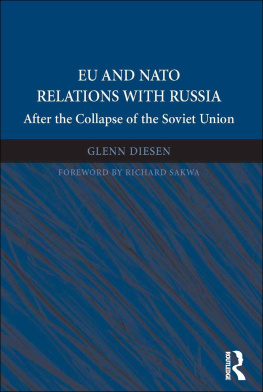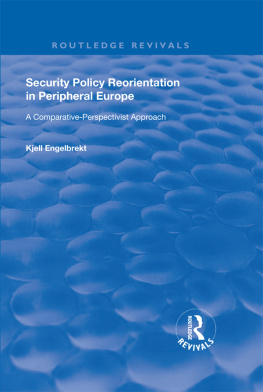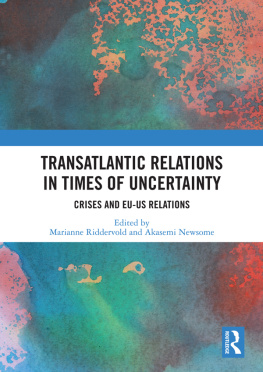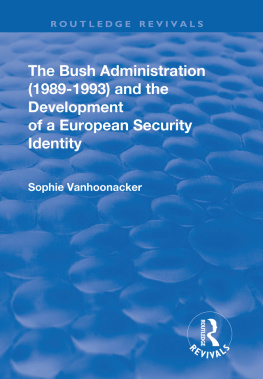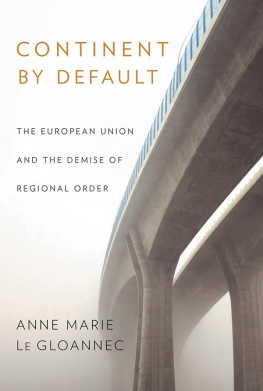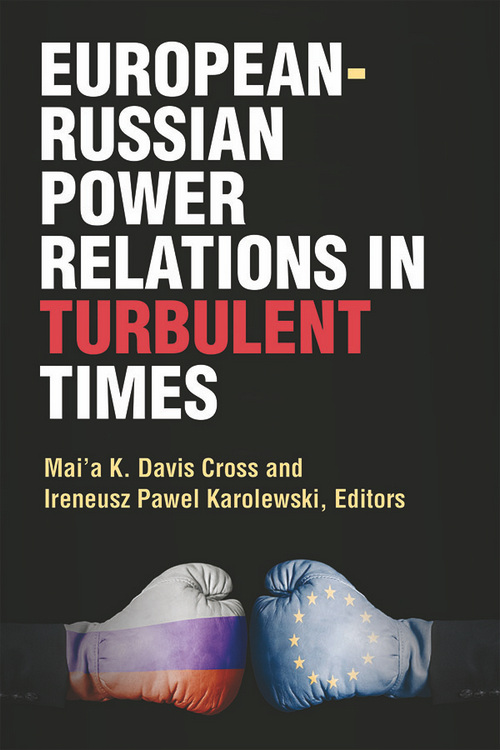
Page i European-Russian Power Relations in Turbulent Times
Page ii Page iii European-Russian Power Relations in Turbulent Times
Edited by Maia K. Davis Cross and Ireneusz Pawe Karolewski
University of Michigan Press
Ann Arbor
Page iv Copyright 2021 by Maia K. Davis Cross and Ireneusz Pawe Karolewski
Some rights reserved

This work is licensed under a Creative Commons Attribution-NonCommercial-NoDerivatives 4.0 International License. Note to users: A Creative Commons license is only valid when it is applied by the person or entity that holds rights to the licensed work. Works may contain components (e.g., photographs, illustrations, or quotations) to which the rightsholder in the work cannot apply the license. It is ultimately your responsibility to independently evaluate the copyright status of any work or component part of a work you use, in light of your intended use. To view a copy of this license, visit http://creativecommons.org/licenses/by-nc-nd/4.0/
For questions or permissions, please contact um.press.perms@umich.edu
Published in the United States of America by the
University of Michigan Press
Manufactured in the United States of America
First published April 2021
A CIP catalog record for this book is available from the British Library.
Library of Congress Cataloging-in-Publication Data
Names: Davis Cross, Maia K., 1977 editor. | Karolewski, Ireneusz Pawe, editor.
Title: European-Russian power relations in turbulent times / Maia K. Davis Cross, Ireneusz Pawe Karolewski.
Description: Ann Arbor : University of Michigan Press, 2021. | Includes bibliographical references and index. |
Identifiers: LCCN 2020055850 (print) | LCCN 2020055851 (ebook) | ISBN 9780472132287 (hardcover) |
Subjects: LCSH : EuropeRelationsRussia (Federation) | Russia (Federation)RelationsEurope.
Classification: LCC D 1065. R 9 E 955 2021 (print) | LCC D 1065. R 9 (ebook) | DDC 355/.0310940947dc23
LC record available at https://lccn.loc.gov/2020055850
LC ebook record available at https://lccn.loc.gov/2020055851
ISBN 978-0-472-90253-8 (OA)
DOI: https://doi.org/10.3998/mpub.10202357
An open access version is made available with the support of libraries participating in Knowledge Unlatched.
Cover illustration from Shutterstock.com / PhotoVectorStudio.
Page v Contents
Maia K. Davis Cross and Ireneusz Pawe Karolewski
Rosella Cappella Zielinski and Kaija Schilde
Helene Sjursen and Guri Rosn
Marianne Riddervold
Cristian Nitiou
Molly Krasnodbska
Ryan C. Maness
Dimitar Bechev
Yulia Nikitina
Vsevolod Samokhvalov
Ireneusz Pawe Karolewski and Maia K. Davis Cross
Digital materials related to this title can be found on the Fulcrum platform via the following citable URL: https://doi.org/10.3998/mpub.10202357
Page 1 1. Introduction Power Dynamics in EU-Russian Relations
Maia K. Davis Cross and Ireneusz Pawe Karolewski
After many years of gradually closer ties between Russia and the European Union (EU), this relationship has taken a turn for the worst, signaling possibly the darkest era in security on the continent since the end of the Cold War. Indeed, at the beginning of the 21st century, it was almost taken for granted that Russia, under Vladimir Putins leadership, was gradually moving closer to the West and valued its relationship to the North Atlantic Treaty Organization (NATO). Many observers pointed to Russias strategic partnership with the West,
Indeed, the international system today is transforming. The liberal world order is coming under threat on various fronts with the rise and growth of nondemocratic states, violent and criminal nonstate actors, asymmetric conflict, and cyber war, among other things. With this climate of uncertainty and insecurity, many states are reverting to less cooperative forms of interaction in the international system, oftentimes resulting in crisis. The Russia-EU relationship is one of the central dynamics behind the emergence of this less stable system. For the EU, increasing Russian aggression and disregard for international law through its encroachments Page 2 into Ukraine is of particular concern. To add to this challenge, the rise to power of the Trump administration created a fundamental rift in the transatlantic security community, compelling Europeespecially the European Unionto rethink its approach to dealing with Russia. Indeed, the Trump administrations destabilizing approach to foreign policy so fundamentally undermined the US image as a trustworthy actor that its impact on the international system is likely to be long-lasting, even if future American presidents try to repair the damage. The challenges at hand are complex, as they do not only involve Russias hybrid warfare in Ukraine but also Russias attempts to influence elections in Europe and the US, manipulation of public opinion through support for pro-Russian right-wing parties, and Russian military pressure against NATO in Europe and in the Middle East. The isolationist policies of the Trump administration added even more to this complexity. While there are many ways in which the liberal world order is under strain, the impact of Russias pivot away from the West disrupts the very core of its foundations, and throws into question what lies in store for the future.
Our study examines the transformations in the Russia-EU relationship from two directions. Part I of the book assesses the ways in which EU foreign policy has changed in light of the Russia threat, and part II of the book shows how and why Russias actions toward the West have changed over timeboth the domestic and international causes. Putting these two major pieces together, we conclude that EU power has been largely reactive, which serves as a source of weakness during these complex and challenging times. However, we also show that recent developments in EU foreign policy indicate that we are potentially turning the corner toward a more proactive EU, which could be a significant source of strength as the liberal world order continues to be tested.
To be clear, we do not seek to analyze both sides in a crisis. Rather, we primarily seek to explore the limitations of the EUs reactive power. From various perspectives, part I of the book reveals how the EU behaved in the Ukraine crisis (and beyond) as a reaction to Russias measures. Part II is not intended to give Russias perspective or side in the current crisis, but rather features chapters on Russia to provide broader context for understanding the EUs actions. Underlying this approach is the recognition that we are dealing with two very different actors that do not find themselves in a similar situation in this crisis: the EU is a complex, democratic, institutional, and hybrid (quasi-federal) type of actor, while Russia is an authoritarian country that is highly secretive and has violated international norms of intervention. The evidence in this book ultimately Page 3 points to the possibility that the EU contributes to the resilience of the liberal world order, even as this order is tested and undergoes transformation. Indeed, for a variety of reasons, some scholars have urged that it is premature to give up on the liberal world just yet.
The chapters in this volume together address three key dimensions of this tumultuous period in Europe-Russia security in the shadow of a new transatlantic divide. First, how and why the power status quo that had been maintained since the end of the Cold War has changed in recent years, as evidenced by Russias newly aggressive posturing. Second, the extent to which the EUs power has been enabled or constrained in light of Russias actions. And third, the risks entailed in Europes
Next page

